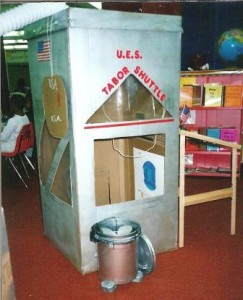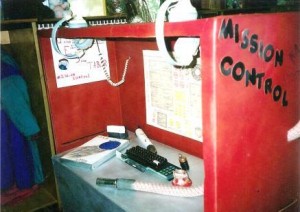
Like any good invention, the Tabor Rotation Framework came out of necessity. A couple of decades ago, I realized that my students needed a better way to learn mathematical concepts. I had almost 40 students in a class, a classroom with no walls, fewer than half of my students on grade level, less than 60 minutes to teach math, and my students would be taking MSPAP (Maryland School Performance Assessment Program). The way I had always taught math wasn’t going to be effective for much longer.
I probably need to digress at this point and explain a little about MSPAP. (This blog may be a bit longer than usual, but to understand why new state assessments like STAAR don’t scare me or teachers who use Tabor Rotation, you have to understand the level of complexity and challenge of Maryland’s performance-based test.) MSPAP was the first and only state test to use a “matrix-sampled design.” This design was a measured format in which a large set of tasks were organized into a number of relatively smaller sets or forms which were randomly assigned to test takers so that no students responded to all of the items. The test consisted of three similar sets or forms, each containing one-third of the total test. Because a given student answered only 1/3 of the questions, scores were aggregated for schools and districts for program evaluation and school improvement.
MSPAP also had other unique features:
- Students took the test for 2.5 hours per day for five weeks days.
- Students had the option to respond to tasks by drawing, graphing, or writing.
- Students worked in small groups to conduct short experiments and used the data collected as a basis for their answers
- The test was composed of theme-based tasks that consisted of only constructed response items that integrated measurement of reading, language usage, writing, mathematics, science, and social studies.
- The test engaged students in “real world” scenarios to assess students’ ability to apply higher order thinking skills and processes.
- In order to mirror the assessment, teachers had to teach in a real-world, performance-based way, and emphasize innovation instead of regurgitation.
Most of the teachers with whom I worked hated MSPAP (I was going to use the word dislike, yet hate truly sums up how they felt), but I thought its design encouraged more effective teaching and learning, so I embraced it. (Okay, those same colleagues would tell you that another parenthetical statement is needed here..I was a little bit obsessed and created performance tasks as a hobby, but teaching and learning this way truly fascinated me!) Schools didn’t know what the experiment was going to be since they didn’t receive the materials for their MSPAP experiments until 3 weeks before the test. Teachers didn’t know which portion of the test each student would take and student responses could be divergent. So, schools and teachers couldn’t “teach to the test.” Instead, they had to base their instruction on state and national standards and teach students to think using their skills and processes in any given situation. Sounds kind of like real life instead of a state test, huh?
My passion for teaching this way and my desire to learn as much as I could to help my students led me to working with ASCD. The Association for Supervision and Curriculum Development was bringing in experts to help Maryland teachers. That’s how I ended up meeting and working with Robert Marzano, Jay McTighe, Deborah Pickering, John Brown, and Cerylle Moffett. All of these theorists were conducting research in Maryland because of its state-wide assessment that was performance-based instead of criterion-based. The practitioners, or teachers, who were making sense of Marzano’s and others’ theories, were encouraged to think outside the box doing things like Tabor Rotation.
In fact, my class and I were featured in a national teleconference on “Performance-Based Assessment Using the Dimensions of Learning Model” with Bob Marzano. The students’ guided tour of the Space Station they designed, built, and manned was part of that teleconference. This clip shows how effectively engaged an extremely large class was in instruction that was meaningful, challenging, and encouraged innovation. I’ll blog later about what cultivates innovation in a classroom, but if you’d like to get a jump start, read Tony Wagner’s book, Creating Innovators: The Making of Young People Who Will Change the World. I believed then, and I believe now that these students are changing the world! [vimeo]http://www.vimeo.com/45767393[/vimeo]The clip clearly reflects the type of instruction being used and the students’ true ownership of the information. The unit of study integrated math, science, writing, language usage, reading, and social studies in a way that Bob was recommending to teachers all over the country. (He still is–read more about Classroom Instruction that Works.)
Teachers who use PBL (Project-Based Learning) and were wondering if Tabor Rotation and PBL were a good fit should be breathing easier at this point. The Tabor Rotation Framework was created to facilitate in-depth study of mathematical concepts in a meaningful way and also to provide for a venue for real-world projects that drive the students to have passion and purpose for the information they are learning.

Now, back to finish the origin of Tabor Rotation…since MSPAP was fully integrated, performance-based, and relied on students’ ability to think critically and creatively, my math instruction was going to have to become more rigorous. That’s when I began to review everything I knew about balanced literacy, small-group instruction, differentiated instruction, critical and creative thinking processes, meaningful application of knowledge, project-based learning, and good, effective teaching strategies. I studied how the brain learns and how students learn best in a classroom. The first few years of Tabor Rotation were a testing ground for essential elements. Mixed grouping at stations, leadership academy, and mathematician’s circle came first. After the first school-wide implementation of Tabor Rotation the scores increased by over 32% in one year—I knew I was on the right track!
Over the next decade, the 14 Essential Elements were identified, implemented, tested, and have continually proven to be essential and effective. Along with the implementation of essential elements, teachers, grade-level teams, and schools piloted versions of the weekly planning guide to make planning for Tabor Rotation simple and user-friendly. The Planning for Readiness Grouping sheet soon became a non-negotiable component to ensure that teachers were using on-going assessment and meeting with all students in readiness groups. Long-range planning guides, phases of implementation, and other templates have been added to assist teachers in small-group, differentiated instruction. Everywhere Tabor Rotation has been implemented, scores go up, students and teachers are changed, and math becomes more meaningful.
Now you know a little bit about the origin of Tabor Rotation. The Tabor Rotation Framework is simply a platform which provides a way for implementing all the things a teacher should already be doing. It reinforces the best practices and gives teachers a concrete way to help every student reach & exceed their potential. Tabor Rotation is a perfect plan for Tier I of Response to Intervention and for implementing small-group instruction in classrooms from pre-K to 12th grade.
Tabor Rotation varies the modality through which students learn concepts. It provides for smaller student-teacher ratio for instructing every student in the room. Tabor Rotation asks teachers to create a continuum of conceptual understanding which provides learning experiences for all students to move “a little bit further than they were the day before.”
Committed educators know they should do what is best for all students…I’m just an educator who figured out a plan that can help them do it and I like sharing it…
[vimeo]http://www.vimeo.com/37837180[/vimeo]

